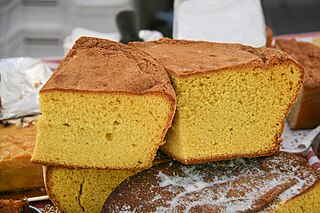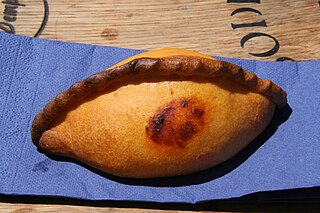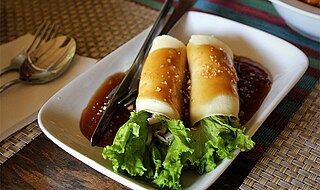
In cuisine, an omelette or omelet is a dish made from beaten eggs, fried with butter or oil in a frying pan. It is quite common for the omelette to be folded around fillings such as cheese, chives, vegetables, mushrooms, meat, or some combination of the above. Whole eggs or egg whites are often beaten with a small amount of milk, cream, or water.

Meatloaf is a dish of ground meat that has been combined with other ingredients and formed into the shape of a loaf, then baked or smoked. The final shape is either hand-formed on a baking tray, or pan-formed by cooking it in a loaf pan. It is usually made with ground beef, although ground lamb, pork, veal, venison, poultry and seafood are also used, sometimes in combination. Vegetarian adaptations of meatloaf may use imitation meat or pulses.

An empanada is a type of baked or fried turnover consisting of pastry and filling, common in Southern European, Latin American, and the Philippines cultures. The name comes from the Galician verb empanar, and translates as "enbreaded", that is, wrapped or coated in bread. They are made by folding dough over a filling, which may consist of meat, cheese, tomato, corn, or other ingredients, and then cooking the resulting turnover, either by baking or frying.

A macaroon is a small cake or cookie, typically made from ground almonds, coconut or other nuts, with sugar and sometimes flavorings, food coloring, glacé cherries, jam or a chocolate coating – or a combination of these or other ingredients. Some recipes call for sweetened condensed milk. Macaroons are sometimes baked on edible rice paper placed on a baking tray.

Comfort food is food that provides a nostalgic or sentimental value to someone, and may be characterized by its high caloric nature, high carbohydrate level, or simple preparation. The nostalgia may be specific to an individual, or it may apply to a specific culture.

Biscocho, also spelled biskotso, refers to various types of Filipino twice-baked breads, usually coated with butter and sugar, or garlic in some cases. Biscocho is most strongly associated with the versions from the province of Iloilo, although it actually exists nationwide in various forms. It is also known as biscocho duro, machacao, or matsakaw.

Picadillo is a traditional dish in many Latin American countries and the Philippines. It is made with ground meat, tomatoes, and also raisins, olives, and other ingredients that vary by region. It is often served with rice or used as a filling in dishes such as tacos, savory pastries or croquettes. The name comes from the Spanish word picar, meaning "to mince".

Bizcocho is the name given in the Spanish-speaking world to a wide range of pastries, cakes or cookies. The exact product to which the word bizcocho is applied varies widely depending on the region and country. For instance, in Spain bizcocho is exclusively used to refer to sponge cake. In Uruguay, most buttery flaky pastry including croissants are termed bizcocho, whilst sponge cake is called bizcochuelo. In Chile, the Dominican Republic and Bolivia bizcocho refers to a sweet dough (masa) baked with local ingredients, similar to the bizcocho from Spain. In Ecuador the dough of a bizcocho can either be sweet or salty. The US state New Mexico is unusual in using the diminutive form of the name, bizcochito, as the name for a locally developed and very popular cookie.

Bolivian cuisine stems from the combination of Spanish cuisine with indigenous ingredients and Aymara traditions, among others, with later influences from Germans, Italians, French, and Arabs due to the arrival of immigrants from those countries. The traditional staples of Bolivian cuisine are corn, potatoes, quinoa and beans. These ingredients have been combined with a number of staples brought by the Spanish, such as rice, wheat, and meat, including beef, pork, and chicken.

Brazo de Mercedes is a traditional Filipino meringue roll with a custard filling typically dusted with powdered sugar. It is a type of pianono.

Puto seco, also known as puto masa, are Filipino cookies made from ground glutinous rice, cornstarch, sugar, salt, butter, and eggs. They are characteristically white and shaped into thick disks. They have a dry powdery texture.

Rosquillos are Philippine cookies made from flour, eggs, shortening, sugar, and baking powder. They were originally created by Margarita “Titay” T. Frasco in 1907 in Liloan, Cebu. The name means "ringlet" in Spanish and was reputedly coined by Philippine President Sergio Osmeña.

Lumpia are various types of spring rolls commonly found in Indonesia and the Philippines. Lumpia are made of thin paper-like or crepe-like pastry skin called "lumpia wrapper" enveloping savory or sweet fillings. It is often served as an appetizer or snack, and might be served deep fried or fresh (unfried). Lumpia are Indonesian and Filipino adaptations of the Fujianese and Teochew popiah, which was created during the 17th century in the former.

Rujak or rojak is a Javanese traditional fruit and vegetable salad dish, commonly found in Indonesia, Malaysia and Singapore.

The prawn cracker is a form of deep fried snack made from starch and prawn. Prawn crackers are a common snack food in Southeast Asian cuisine, but they are most closely associated with Indonesia and Malaysia. They have also been adapted into East Asian cuisines.

Uraró, also known as araró or arrowroot cookies, are Filipino cookies made from arrowroot flour. They have a dry and powdery texture and are usually flower-shaped. They originate from the Tagalog people of southern Luzon, particularly in the provinces of Laguna, Quezon, and Marinduque.

Jacobinas are Filipino biscuits. They are distinctively cubical in shape, resembling a thicker galletas de patatas. The biscuit was first produced by the Noceda Bakery in 1947 by Paterno Noceda, and remains a registered trademark in the Philippines. The biscuits are sold by the Noceda bakery in the Philippines and by the Jacobina corporation in the United States and other Asian countries. Jacobinas are traditionally eaten paired with coffee for breakfast.

Paborita are Filipino disc-shaped biscuits with a flaky texture. They are made with wheat flour, sugar, skim milk, salt, baking powder, alum, and cooking oil. They are very similar in taste to galletas de patatas. They are traditionally eaten paired with hot drinks or with fruit preserves.

Paciencia, also known as Filipino meringue galyetas or galletas paciencia, are Filipino cookies made with beaten egg whites, flour, and calamansi. They are typically hemispherical in shape. The name means "patience" in Spanish. They are traditionally eaten during the Christmas Season.

Ugoy-ugoy, also spelled ogoy-ogoy, are Filipino layered biscuits. They are typically rectangular or ribbon-like in shape and are topped with granulated sugar. It is particularly associated with the city of Iloilo.





















